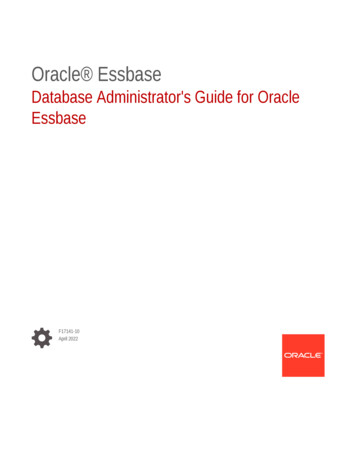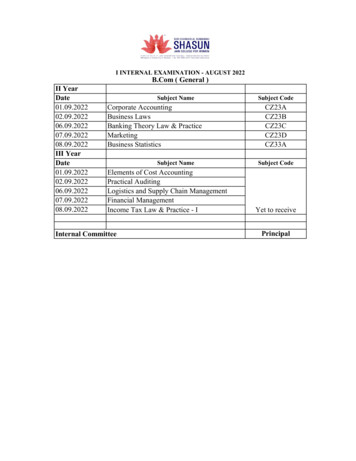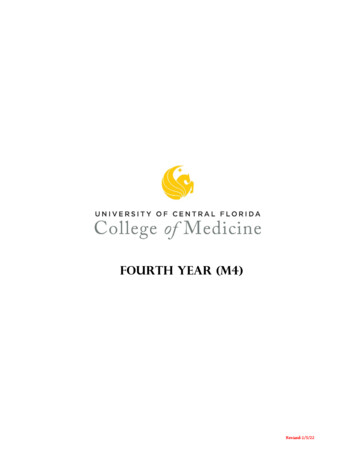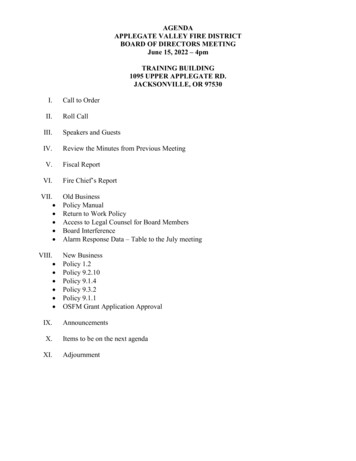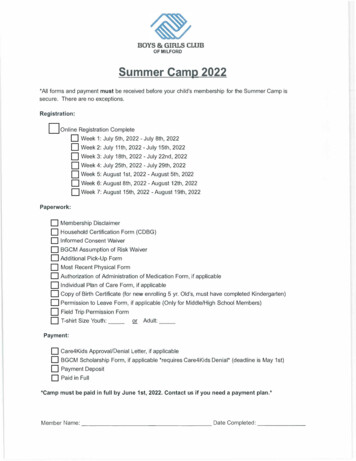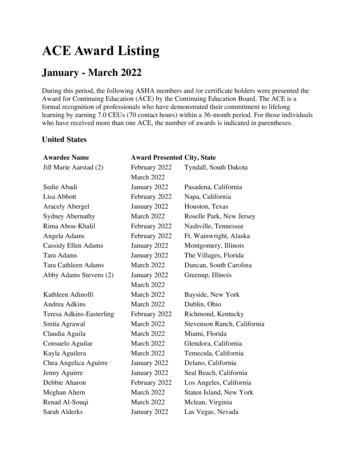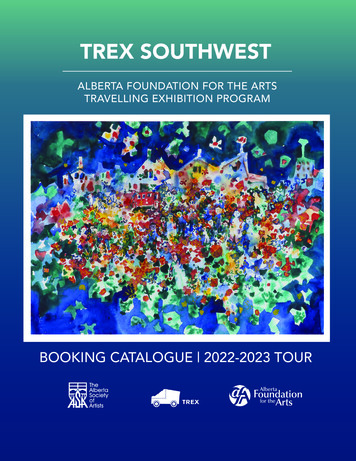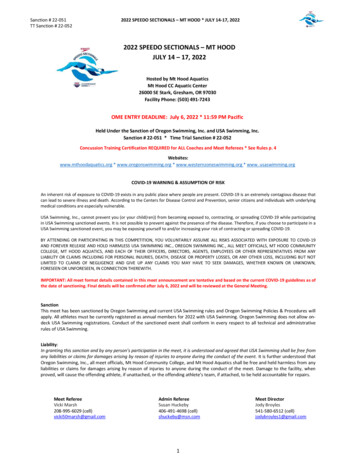
Transcription
University of Massachusetts Amherst2022-2023Guide to UnderstandingFinancial Aid
Message from Financial Aid ServicesFinancial Aid ServicesUniversity of Massachusetts AmherstUMass Amherst Financial Aid Services is committed to working with students and families to providethe best possible information about available financial aid resources.We created this guide to help you understand the components of your financial aid award, as well asthe options available for financing your education.What is the best way for you to pay for a UMass Amherst education? The first step should includereading this guide and understanding your options. Then take a careful look at your householdbudget and determine what funds are available to cover educational expenses and any potentialadditional funds you may have.When planning how to finance your education, it is important to plan your expenses for the entireacademic year. Included in this guide is information about paying your University bill and an expenseworksheet to help you estimate what that amount will be.Financial Aid Services staff can assist you with questions you may have regarding your financial aidaward and available financing options.To connect, call (413) 545-0801 or by email at finaid@finaid.umass.edu.We look forward to working with you!It all starts with the FAFSA!Apply for financial aid at studentaid.gov1
Eligibility for Financial AidStudents, and parents of dependent students, have the primary responsibility to pay for college. Financial aid is meantto supplement that responsibility. Eligibility for financial aid begins with filing the Free Application for Federal StudentAid (FAFSA). The FAFSA should be completed online at studentaid.gov each academic year. The information provided onthe FAFSA is used by the Central Processing System (CPS) to determine an expected family contribution (EFC). The EFC isthe initial indicator of what types of grants and/or loans you may be eligible for.In addition, financial aid applicants must meet the following key criteria to receive most types of financial aid: Be enrolled in a degree-granting program. Be a United States citizen, permanent resident or eligible non-citizen as defined by the federal government. Be enrolled in at least six credit hours each semester (some forms of financial aid require full-time enrollment,12credits). Maintain satisfactory academic progress toward completion of your degree. Additional eligibility requirements may apply.At UMass Amherst, students applying for financial aid are considered for a variety of programs based on eligibility.Programs include federal, state and institutional sources of aid. Initial financial aid award packages may includeneed-based and non-need based grants, loans and work-study programs.Need-Based Financial Aid is awarded based on the availability of funds to students who have demonstratedfinancial need. You have financial need when your EFC is less than your estimated cost of attendance (COA). UMassAmherst determines your COA. The CPS determines your EFC using the U.S. Department of Education’s formula.Need-based financial aid includes federal, state and university grants, subsidized student loans and work-study.Non Need-Based Financial Aid is awarded when you have no financial need, i.e. your EFC is greater than theCOA. In this case, you only qualify for non need-based aid, which includes the Federal Direct Unsubsidized Loan.Graduate Students on Program Fee or Continuous EnrollmentGraduate students who are not enrolled for any course credits but who are candidates for a degree must pay a program fee eachsemester to be considered for continuous enrollment until the degree is formally awarded. Program Fee students may be eligiblefor a Federal Direct Unsubsidized Loan if the work on their degree requirements is classified as equivalent to at least half-time(six credits per semester). If you are on program fee and would like to borrow a Direct Loan, you must update your enrollment statuseach semester with the Graduate Student Service Center at 534 Goodell Building by providing them with a letter from your Program Director.It is your responsibility to notify Financial Aid Services, as your loan eligibility will be affected. Financial aid eligibility is directly related toyour billed expenses.Graduate Non-Degree StudentsGraduate non-degree students enrolled at least half-time (six credits per semester) may be eligible for a Federal Direct Unsubsidized Loanfor up to 6,250 per semester only under the following conditions: the student applied for admission to a graduate degree program, will beconsidered for admission at a later date, and the coursework is verified by a Graduate Program Director as prerequisite for admission to adegree program. A memo from the Graduate Program Director to Financial Aid Services is required each semester to verify this informationbefore a non-degree student may be awarded Federal Direct Unsubsidized Loans. A non-degree sample letter is available on our website ts/eligibility. Please note that after 12 consecutive months (two semesters) ofnon-degree status, you must be enrolled in a degree-granting program to be considered for a Federal Direct Unsubsidized Loan. Studentsare only eligible to receive federal loans as a non-degree student once during their lifetime.2
Estimated Cost of Attendance (COA)COA is the amount we estimate it may cost you to attend UMass Amherst for one academic year. A student’seligibility for financial aid is not based on individual preferences and spending habits, but on the standard budgetallowances developed by UMass Amherst. These costs have been developed as guides to help students anticipatetheir educational expenses. Some students will spend more than the estimated amounts, others less, dependingon individual lifestyles and circumstances. COA includes billed and non-billed expenses.Costs for the academic year are based on estimated information. The University of Massachusetts Board ofTrustees approves final charges in July prior to the start of the fall term, therefore estimates are subject tochange. Visit the Bursar’s website at umass.edu/bursar for up-to-date 2022-2023 tuition, fees and room andboard charges.Estimated Cost of Attendance for 2022-2023 There may be additional charges not listed below thatappear on your University bill. These additional fees may be based on the student’s career, level and program. Forexample: counseling fee, entering fee, Engineering fee, Honors College fee, Isenberg fee, lab fees, program fees andcommencement fee are not listed below.Undergraduate Students: Full-time enrollment and living on campus.In-StateOut-of-State**InternationalTuition & Fees 16,834 38,053 40,438Room & Board 14,644 14,644 14,644Books & Supplies 1,000 1,000 1,000Personal & Transportation 1,400 1,400 1,400Total ESTIMATED Cost of Attendance 33,878 55,097 57,482**New England Regional Students Program (NERSP) gives a tuition break to New England residents enrolled in certain programs not offered by the public collegesand universities of their home state. Your bill will reflect the full cost of out-of-state tuition and fees and either the New England regional discount, or for those whoare eligible, the out-of-state merit award. Students receive either the regional discount or the merit award, but not both.Billed expensesare the charges that appear on your Universitybill. These include tuition, fees, and on-campusroom and board.Non-billed expensesare the cost of items such as books, supplies, off-campusroom and board, personal expenses (clothing, laundry,recreation), and transportation needs.Other charges or fees that may appear on your bill that are not included in your COAStudent Health Plan - Massachusetts state law requires that students enrolled at a college or universitycarry comprehensive health insurance. This fee may be waived upon request if your health insurance meets theMassachusetts state requirements. Otherwise you will be charged for the Student Health Plan every semester.For detailed information on the cost of this fee, please visit: umass.edu/bursar.The Financial Aid Services website has information to assist in determining your estimated cost of attendanceat umass.edu/financialaid. This includes information for part-time undergraduates and graduate students.3
Types of Financial AidNeed-Based Financial AidGrants & ScholarshipsWork-Study & Subsidized Loans Federal Pell Grant Federal Work-Study (FWS)is a federally funded program that provides studentsis awarded to full and part-time undergraduatestudents who demonstrate exceptional need andare seeking their first bachelor’s degree. Awards arelimited to the equivalent of 12 full-time semesters.Final eligibility determination is required.with funding to obtain part-time employment. Studentstypically work 10-15 hours per week and receive abiweekly paycheck. Earnings are taxable. FWS is not applied to your University bill. FWS can be used for on-campus hourly employment andat APPROVED FWS off-campus sites. For available jobs bs-board. You can have more than one job; however, you may notwork more than eight hours per day and should not workmore than 20 hours per week while school is in session. Earnings from Federal Work-Study jobs are excluded fromincome on future year FAFSA. MASSGrant Programis a need-based grant funded by appropriations fromthe Massachusetts Legislature for Massachusettsresidents. Eligible undergraduate students must takeat least 12 credits each semester, be seeking their firstbachelor’s degree and file the FAFSA by May 1, 2022.Award amounts are determined by the MassachusettsDepartment of Higher Education. FSEOG (Federal Supplemental EducationalOpportunity Grant) William D. Ford Federal Direct Subsidized Loanis awarded to Federal Pell Grant eligible students.Awards range from 200 to 2,000. Students enrolledpart-time may also be eligible for FSEOG. Not allFederal Pell Grant eligible students are awardedFSEOG due to limited funding.is a low-interest loan funded by the federal governmentand available to eligible undergraduate and UniversityWithout Walls (UWW formerly known as CPE) studentsenrolled at least half-time who complete the FAFSA. Acredit check is not required to receive this loan. DirectSubsidized Loans are awarded based on demonstratedneed. University Awardsare awarded in the form of grants, tuition credits andscholarships. These funds are awarded to full andpart-time eligible undergraduate students seekingtheir first bachelor’s degree. Please note that some ofthe university academic grants and awards have gradepoint average (GPA) requirements. A student may onlyreceive one tuition credit per semester regardless ofthe source of the credit. All awards are subject to fundavailability. The current interest rate for 2022-2023 is fixed at 3.73%. There is a 1.057% origination fee retained by the federalgovernment. The interest rate and origination fee are subject to change. The government pays the interest while the student is inschool. Repayment begins six months after the student leavesschool or drops below six credits. State Financial Aid Programs First-time borrowers are required to complete a MasterPromissory Note (MPN) and Entrance Counseling atstudentaid.gov before the loan funds are disbursed totheir university bill.may be available from your state of residence. Visityour state department of higher education websiteto get information regarding available financial aidprograms. Massachusetts residents should visitmass.edu/osfa for more information.All financial aid programs are subject to change due to external factors.4
Types of Financial AidNon Need-Based Financial Aid William D. Ford Federal Direct Unsubsidized Loanis a non need-based, low-interest loan funded by the federal government and available to degree-seekingundergraduate and graduate students enrolled at least half-time who complete the FAFSA. A credit checkis not required to receive this loan. The current interest rate for 2022-2023 is fixed at 3.73% for undergraduate and 5.28% graduate students.There is a 1.057% origination fee retained by the federal government.The interest rate and origination fee are subject to change.Interest accrues from the date the loan is disbursed and may be paid while in school or capitalized (added to the principal)at a specified time. Student borrowers are billed quarterly for the interest. Repayment begins six months after the student leaves school or drops below six credits. First-time borrowers are required to complete a Master Promissory Note (MPN) and Entrance Counseling at studentaid.govbefore the loan funds are disbursed to their university bill. William D. Ford Federal Direct PLUS LoanDirect PLUS loans are federal loans that graduate or professional degree students and parents of dependentundergraduate students can use to help pay for education expenses. Direct PLUS loans have a fixed interest rate currently 6.28%and are not subsidized, which means that interest accrues while the student is enrolled in school. An origination fee, currently4.228% is charged to process a Direct PLUS Loan and is deducted from the loan disbursement before the funds are paid to thestudent's account. A current year FAFSA must be filed before applying for a PLUS Loan.There are two types of Direct PLUS loans: the Grad PLUS loan and the Parent PLUS loan.Grad PLUS loans allow graduate and professional students to borrow money to pay for their own education. Graduatestudents can borrow Grad PLUS loans to cover any costs not already covered by other financial aid or grants, up to the fullcost of attendance.Parent PLUS loans allow parents of dependent students to borrow money to cover any costs not already coveredby the student’s financial aid package, up to the full cost of attendance. Parent PLUS loans are the financial responsibilityof the parents, not the student. Parent PLUS loans accrue interest while the student is enrolled in school and have no “graceperiod.” A grace period is a time after the student graduates, leaves school, or drops below half-time enrollment when you don’thave to make payments. Parents must start repaying PLUS loans as soon as the loan is fully disbursed. However, parents may beable to request a deferment to delay making payments while their student is in school at least half-time enrollment bycontacting their loan servicer.To apply for a PLUS loans visit our website at umass.edu/financialaid/forms. Private Student Loans/Alternative LoansThese are educational loans offered by private lenders to provide funds to pay for educational expenses. They are notpart of the federal student loan program and generally do not feature the flexible repayment terms or the borrowerprotections offered by federal student loans. Private student loans typically have both variable and fixed interest rates.Most private loans required you to apply with a co-signer. The interest rates and fees you pay on a private student loanare based on your credit score and the credit score of your co-signer, if you choose to have one. You should always exhaustyour eligibility for federal student loans before resorting to private student loans.Visit our website at umass.edu/financialaid for a list of private loan programs and lender application information.5
Direct Loan Borrowing RequirementsFederal Direct student loans are an investment in your future. You should not be afraid to take out federal student loans,but you should be smart about it. Before you take out a loan, it’s important to understand that a loan is a legal obligationthat makes you responsible for repaying the amount you borrow with interest. Even though you don’t have to beginrepaying your federal student loans right away, you shouldn’t wait to understand your responsibilities as a borrower.Keep track of how much you’re borrowing. Understand the terms of your loan and keep copies of your loan documents.Think about how the amount of your loans will affect your future finances, and how much you can afford to repay. Yourstudent loan payments should be only a small percentage of your salary after you graduate, so it’s important not toborrow more than you need for your school-related expenses.Please note that a combination of student loans is included in most undergraduate financial aid awards. You may choose notto borrow the loan(s) awarded or borrow a lesser amount than offered. Remember, loans are debts that must be repaid withinterest, consider your options and other resources prior to borrowing student loans.First-time borrowers are required to complete the following documents before they receive loan funds: Loan Agreement for Subsidized/Unsubsidized Loan-Master Promissory Note(MPN)When you sign a promissory note, you are agreeing to repay the loan according to the terms of the note regardless ofcompletion of educational program or employment status. This is a legal document in which you promise to pay backthe loans with interest. The MPN covers both Federal Direct Subsidized and Federal Direct Unsubsidized Loans and isvalid for 10 years. If you become eligible for more loan funds, your MPN will cover all loan increases. In subsequentyears, Financial Aid Services will notify you of your loan eligibility. Please note the MPN may become invalid or expiredif there is no disbursement activity for twelve consecutive months, in which case a new MPN will have to be signed ifyou wish to borrow additional federal loans. If you are a first-time borrower complete the MPN at studentaid.gov. Direct Loan Entrance Counseling is a tool to ensure you understand your responsibilities to repay theloan and the obligations you are assuming. The Entrance Counseling is required of all first-time borrowers thatchoose to accept a Federal Direct Loan. If you are a first-time borrower complete the Direct Loan EntranceCounseling at studentaid.gov.All Direct Loan borrowers are required to complete: Direct Loan Exit Counseling If you are a student who has received subsidized, unsubsidized or PLUS loansunder the Direct Loan Program or the FFEL Program, you must complete exit counseling each time you: drop belowhalf-time enrollment, graduate, or leave school. The exit counseling provides important information that you need asyou prepare to repay your federal student loan(s). Topics include: Understanding Your Loans, Loan Servicers, RepaymentPlans, Avoiding Default, Deferment, Forbearance, and Making Finances a Priority. Visit studentaid.gov for informationabout and completing the Exit Counseling.Learn more about Federal Direct Loans, the MPN and Entrance and Exit Counseling at studentaid.gov6
Graduate Student Financial AidThe Federal Direct Unsubsidized Loan is the primary source of financial aid for many graduatestudents. The annual loan award is based on the cost of attendance and individual eligibility, with amaximum annual limit of 20,500.Note: When awarding a Federal Direct Unsubsidized Loan to graduate students we assume that they are receiving agraduate appointment, (also called a graduate research or teaching assistantship). If you do not receive agraduate appointment, please contact Financial Aid Services as this may increase the amount of loan you areable to receive. You may be able to receive up to the annual maximum.This assumption does not apply to students enrolled in UWW online graduate programs.Other Alternative Loan Options for Graduate StudentsThe Federal Direct Graduate PLUS Loan is available to creditworthy graduate students in need of fundsbeyond those provided by the Federal Direct Unsubsidized Loan.To apply for a Graduate PLUS Loan:Graduate PLUS Loan Eligibility and Requirements: Complete the Direct Graduate PLUS Loan Application formavailable at umass.edu/financialaid/forms. PLUS Loans are disbursed directly to the student’s Universitybill, generally in two disbursements. Repayment starts six months after you graduate, leave school,or drop below half-time enrollment. Interest rate is currently fixed at 6.28% with anorigination fee of 4.228% ( both subject to change). For more information on the Federal Direct Graduate PLUSLoan, visit studentaid.gov or contact Financial Aid Servicesat (413) 545-0801. Enrolled at least half-time in a degree program. File the 2022-2023 FAFSA and maximize eligibility for FederalDirect Unsubsidized Loan. Have good credit history, and no default in any federal loan. May borrow up to the cost of attendance for the period ofenrollment, minus other financial assistance received. First time GRAD PLUS borrowers with approved credit mustcomplete a Direct PLUS Loan Master Promissory Note(PLUS MPN) and Loan Entrance Counseling at studentaid.govMEFA Graduate Loan is offered by MEFA, a non-profit state authority offering low fixed interest rate loans forgraduate students. For students needing help financing their graduate education, a MEFA Graduate Loan can be usedto cover all or part of the amount due to the University. Unlike many private loans, the MEFA Graduate Loan offers lowfixed interest rate options. MEFA loans are disbursed directly to the school in two installments and are applied to thestudent’s University bill. There are no origination or application fees. The Student and/or co-borrower must meetMEFA’s credit standards.Visit mefa.org/loans for up- to- date 2022-2023 rates and options.Current Fixed Interest Rates Ranges: Deferred Repayment Option: 4.55% - 5.50%(Repayment starts six months after graduation, dropping below six credits or leaving school). Interest-Only Repayment Option: 4.25% - 5.40%.(Interest payment starts 45 days after final disbursement).Apply online at mefa.org/loans or call (800) 449-MEFA (6332).7
Federal Direct LoansAnnual and Lifetime LimitsUndergraduateand UWW onal unsubsidizedfor dependent students whoseparent is denied a PLUS LoanFirst Years(0-26 credits) 5,500(up to 3,500subsidized) 9,500(up to 3,500subsidized) 4,000/per yearSophomores(27-56 credits) 6,500(up to 4,500subsidized) 10,500(up to 4,500subsidized) 4,000/per yearJuniors/Seniors(57-120 credits) 7,500(up to 5,500subsidized) 12,500(up to 5,500subsidized) 5,000/per yearMaximumUndergraduateAmount 31,000(up to 23,000subsidized) 57,500(up to 23,000subsidized)Graduate Students Annual and Lifetime Direct Loan LimitsGraduateStudentsAnnual Unsubsidized Limit 20,500Graduate Maximum LifetimeAmount (including loans borrowedas an undergraduate) 138,500Debt ManagementA college education is the best investment you can make for your future, but it can be a costly one without acareful borrowing plan. Student loans are an excellent resource to pay for educational costs, but the amount ofdebt incurred should be considered carefully.Taking out student loans to pay for college has long-term financial implications. Like any other debt, a studentloan is a serious financial obligation that must be repaid with interest when you leave school. Failure to repayyour student loans may affect your credit rating and your ability to borrow for other purposes.It is important to plan for the entire cost of your education and consider how much you need to borrow to meet thatcost while keeping your debt at a manageable level. Be sure you understand your rights and responsibilities under eachloan program before you accept any student loan.Repaying Your Federal Direct Loans Repayment of principal and interest begins six months after leaving school or dropping below six credits. You mustrepay student loans even if your financial circumstances become difficult. You make payments to your loan servicer. William D. Ford Federal Direct Loans are serviced by multiple Federal LoanServicers. To find out who your loan servicer is, call the Federal Student Aid Information Center (FSAIC) at 1-800-433-3243. You are responsible for staying in touch with your servicer and notifying them of any changes. Borrowers of Direct Loans have multiple flexible repayment options. You may be eligible for a deferment or forbearance on your federal student loans.For more information about repaying your Federal Direct Loans visit studentaid.gov8
Examples of Direct Loan RepaymentPayment calculated using the Standard Repayment Plan and fixed interest ratesThe following charts give examples of monthly payments for specific loan amounts under the Standard Repayment Plan of 10years. Amounts are rounded to the nearest whole dollar and represent minimum payments at the interest rate indicated. They donot include interest that may accumulate during periods of deferment or forbearance. This chart is for estimating purposes only.To calculate your actual repayment visit studentaid.gov. If you need more information on debt management contact UMassAmherst Financial Aid Services.GRADUATE- Federal Direct Unsubsidized Loans*UNDERGRADUATE- Federal Direct Subsidized andUnsubsidized Loans*Total Loan DebtAt RepaymentMonthlyPaymentTotal Amount Paid ,5000 50 6005 10,000 100 12,013 15,000 150 18,020 20,000 200 24,026 25,000 250 30,033 30,000 300 36,039 35,000 350 42,046 40,000 400 48,052 45,000 450 54,059 50,000 501 60,065 57,500 576 69,075Total Loan DebtAt RepaymentMonthlyPaymentTotal Amount Paid 10,000 108 12,910 20,000 215 25,821 30,000 323 38,731 40,000 430 51,642 50,000 538 64,552 60,000 646 77,463 70,000 753 90,373 80,000 861 103,284 90,000 968 116,194 100,000 1075 129,105 138,500 1,490 178,809*Payment calculated using a fixed interest rate of 5.31%over a 10 year period.*Payment calculated using a fixed interest rate of 3.76% overa 10 year period.Federal Direct PLUS Loans*Total Loan DebtAt RepaymentMonthlyPaymentTotal Amount PaidThe Standard Repayment Plan Is the basic repayment plan for loans from theWilliam D. Ford Federal Direct Loan (Direct Loan)Program and Federal Family Education Loan (FFEL)Program. Payments are fixed and made for up to 10 years. This repayment plan saves you money over timebecause you pay off your loan in the shortest time. All Direct Loan borrowers are eligible for this plan. Do not choose this plan if you will be seeking PublicService Loan Forgiveness (PSLF) 10,000 113 13,510 20,000 225 27,020 30,000 338 40,530 40,000 450 54,040 50,000 563 67,550 60,000 676 81,060 70,000 788 94,570 80,000 900 108,080 90,000 1,013 121,590 100,000 1,126 135,100*Payment calculated using a fixed interest rate of 6.31%over a 10 year period.Learn about loan Repayment Plans at studentaid.gov/manage-loans/repayment/plans9
Other Repayment PlansIn addition to the Standard Repayment Plan, there are seven more repayment plans outlined below. Contact your loan servicerto determine your eligibility for the different plans or visit: studentaid.gov.Repayment PlanMonthly Payment CalculationRepaymentLengthGraduated *Payments start low and increaseevery two years.Up to 10 yearsAll Direct Loan borrowersExtended *Payments may be fixed or graduated.Up to 25 yearsBorrowers with more than 30,000 inDirect LoansPay As You Earn (PAYE)**Payments will be 10 percent of discretionaryincome and is calculated on yearly AGI, family size.Up to 20 yearsNew Direct Loan borrower on or afterOctober 1, 2007.Revised Pay As You Earn(REPAYE) **Monthly payment will be 10 percent ofdiscretionary income. Recalculated each yearbased on updated income and family size.Up to 20 yearsAll Direct Loan borrowersIncome- Based (IBR)**Payment will be 10 or 15 percent ofdiscretionary income and is calculated each yearbased on AGI, family size.Up to 20 yearsBorrowers with high debt relative toincomeUp to 25 yearsAll Direct Loan borrowersUp to 15 years*Only Federal Family Education LoanProgram (FFELP) borrowersIncome Contigent (ICR)** Payment will be 20 percent of discretionaryEligible Borrowersincome. Payment is calculated each year based onAGI, family size and total loan debt.Income-SensitivePayment is calculated based on annualincome.You will pay more over time under any of these repayment plans than under the Standard Repayment Plan.You can change repayment plans at any time.* Repayment Plan does not qualify for Public Service Loan Forgiveness (PSLF) program.** Repayment Plan is a good option if you will be seeking Public Service Loan Forgiveness (PSLF).What is Public Service Loan Forgiveness (PSLF)?If you are employed by a U.S. federal, state, local, or tribal government or not-for-profit organization, you might be eligiblefor the Public Service Loan Forgiveness Program. The PSLF Program forgives the remaining balance on your Direct Loansafter you have made 120 qualifying monthly payments under a qualifying repayment plan while working full-time for aqualifying employer. Learn more about PSLF tion/public-service#qualifyLearn about loan Repayment Plans at studentaid.gov/manage-loans/repayment/plans10
Your Rights and Responsibilitiesas a Student Loan BorrowerRightsResponsibilitiesYou have the right to:You are responsible for: A “grace period” before your repayment begins.The grace period starts when you leave school ordrop below half-time status, half-time is 6 credits. Keeping accurate records of your federal studentloans. Repaying your federal student loans, plusinterest, even if you did not finish your program,are unable to get a job, or are unhappy with theeducation received, according to the repaymentschedule your lender will give you. Loan deferments, forbearance, and to know theconditions under which your loans can becancelled and/or repaid by the Department ofEducation. An explanation of default and its consequences. Using your loan money only for tuition and otherrelated educational expenses. A loan repayment schedule, an explanation ofrefinancing and consolidation options, and youroption to pre-pay your loan at any time withoutpenalty. Completing a Direct Loan Exit Interviewbefore you leave school, which may b
Financial Aid Services University of Massachusetts Amherst . Honors College fee, Isenberg fee, lab fees, program fees and commencement fee are not listed below. Undergraduate Students: Full-time enrollment and living on campus. In-State Out-of-State** International Tuition & Fees 16,834 38,053 40,438 Room & Board 14,644 14,644 14,644


